Serviços Personalizados
Journal
Artigo
Indicadores
-
 Citado por SciELO
Citado por SciELO -
 Acessos
Acessos
Links relacionados
-
 Similares em
SciELO
Similares em
SciELO
Compartilhar
Psicologia, Saúde & Doenças
versão impressa ISSN 1645-0086
Psic., Saúde & Doenças vol.14 no.3 Lisboa nov. 2013
Kidscreen -52: parents perception of their childrens quality of life
Kidscreen-52: a perceção dos pais sobre a qualidade de vida dos filhos
Margarida Gaspar de Matos1,2, Tania Gaspar2,3, Celeste Simões1,2 & The European KIDSCREEN Group
1-Universidade de Lisboa, Portugal
2-Centro da Malária e Doenças Tropicais, Portugal
3-Universidade Lusíada, Portugal,
ABSTRACT
The KIDSCREEN 52 is a European cross-cultural and standardized instrument that assesses ten health related quality of life (HRQoL) dimensions in children, adolescents and their parents. It is often claimed that children self reports are not totally accurate, calling for a confirmation from parents or caregivers. The present study focuses only on the Kidscreen-52, parents version (a parallel version addressed specifically to parents perceptions of their sons HRQoL). 2255 parents of children and adolescents with a mean age of 13.2, attending the 5th grade and 7th grade were inquired. The fit indexes indicate good fit to the data. Specifically, the final solution of the RMSEA was lower than .03, the upper limit of 90% confidence interval was lower than .05, and CFI was higher than .95. Results indicate that the current 52 items structure is invariant across gender and age group. The parents version of the Kidscreen-52 questionnaire constitutes a valid instrument to estimate parents perception of quality of life in their children.
Keywords- Assessment, Children and Adolescents, Health-Related Quality of Life, Parents views, proxy version
RESUMO
O Kidscreen-52 é um instrumento europeu inter-cultural e padronizado que avalia 10 dimensões da qualidade de vida relacionada com a saúde (QVRS) em crianças, adolescentes e seus pais. Afirma-se frequentemente que os auto-relatos de crianças não são totalmente precisos, sendo necessária uma confirmação por parte dos pais ou responsáveis. O presente estudo refere-se ao Kidscreen-52, versão para pais (uma versão paralela dirigida especificamente aos pais quanto à perceção de QVRS dos seus filhos). Participaram 2.255 pais de crianças e adolescentes com idade média de 13,2 anos , frequentando o 5º e o 7º anos de escolaridade. Os índices de ajustamento indicam bom ajustamento dos dados. Especificamente, na solução final o RMSEA foi menor do que 0,03, o limite superior do intervalo de confiança de 90% foi inferior a 0,05, e CPI foi maior do que 0,95. Os resultados indicam que a atual estrutura de 52 itens é invariante em relação ao gênero e à idade. A versão para pais do questionário Kidscreen-52 constitui um instrumento válido para estimar a perceção dos pais acerca da qualidade de vida relacionada com a saúde dos seus filhos, crianças e adolescentes.
Palavras-chave- Avaliação, crianças e adolescentes, Qualidade de Vida relacionada com a Saúde, perspetiva dos pais, versão proxy
There are several factors that influence the perception of health-related quality of life(HRQol) of children and adolescents. The factors found can be organized into two broad categories: personal characteristics and social characteristics. Studies on the subjective well-being of children and adolescents are recent and focus on the relationship between demographic variables (e.g. age, gender and socioeconomic status), intrapersonal characteristics (e.g. self-concept, extraversion, locus of internal control) and welfare (Gaspar, 2010; Gaspar, et al, 2010 a) b);Ravens-Sieberer, et al, 2001).
An ecological perspective including children or adolescents, parents and family, peers, school and community allow a greater understanding of the development and psychosocial well-being of both children and adolescents (Matos & Social Adventure team, 2012; Nelson, Laurendeau & Chamberland, 2001). The social network and the perceived social support are extremely important for children's and adolescents' development. The structure and functions of social support are related to specific aspects of their welfare, particularly regarding self-concept, adjustment, and social skills as protective factors against stressful life events (Boosman, Meulen, Geert & Jackson, 2002).
Ideally, the instruments to evaluate HRQoL for children/adolescents could use both children/adolescents views and their parents, allowing a more precise multi-informant evaluation and a more thorough comparison between parents and children/ adolescents perceptions (Eiser & Morse, 2002; Varni, Limbers & Burwinkle, 2007).
Theunissen et al., (1998) defended that it is possible to evaluate the HRQoL through the perception of both the child and his parents, claiming that in both cases valid information is reported, although parents showed a better performance in most areas. Several investigations show that the agreement between parents and children is very good when it comes to observable measures, ie, it is expected a greater agreement between parents and children in the evaluation of the health status than in perception of health related quality of life. The social and psychological aspects of HRQOL are less observable than the physical aspects of HRQoL. Most children have a more pessimistic view about their physical functioning than their parents, the same occurring with the dimensions related to cognitive functioning and with positive and negative emotions (the psychological aspects of HRQoL).
Age differences were found in parent-child agreement in term of emotions. Regarding the perception of positive, in the items related to welfare and emotional aspects, there is less agreement among the older children and parents than among the younger ones emotions (Chang & Yeh, 2005; Gaspar, et al, 2010, Jocovic, Locker & Guyatt, 2004). These results may reflect the fact that older children spend more time away from parents, have less parental supervision and share less of their living experiences with their parents and more with peers (Matos & Sampaio, 2009).
Results highlight that parents are better able to assess the physical aspects of HRQoL of their children than the social and emotional aspects. On the other hand, the differences between ratings of parents and children may depend on the instrument used and especially on the domain of HRQoL that is being evaluated (Eiser & Morse, 2001).
The KIDSCREEN-52 is an instrument that assesses 10 dimensions of health-related quality of life (HRQoL). It was developed as a result of studies by the European KIDSCREEN Group, University of Berlin (The KIDSCREEN Group Europe, 2006; Ravens-Sieberer et al, 2001). During the Portuguese validation process, a model was developed to examine the perceptions of children and their parents on these dimensions (Gaspar & Matos, 2008).
The aim of the present study was 1) to examine the psychometric properties of the Portuguese parents version of KIDSCREEN-52 instrument; 2) to analyse similitude and differences of parental perceptions regarding their childrens gender and age; 3) to analyse children/adolescents perceptions compared with theirs parents.
METHODS
Participants
Sampling methods were derived from the international study Health Behaviour in School-Aged Children (HBSC/WHO). The HBSC/WHO studys sample was enlarged, and two extra random classes (5th grade and 7th grade) were selected in each of the national randomly selected schools. Schools were stratified by National Educational Regions (5 in the whole country) following HBSC/WHO. (For further details about sampling procedures, see Currie, Samdal, Boyce, & Smith, 2001; Matos et al, 2003, 2012). The present study is a cross sectional national study, representative of Portuguese public schools, and provides a random national representative sample of 5th and 7th grade pupils.
KIDSCREEN-52 questionnaires were applied in a classroom setting. Questionnaires were anonymous and answered in a voluntary basis. The research project was submitted and approved by several national organizations (Ministry of Education, National Data Protection Commission and Ethics Commission) and parents informed consent was requested.
The study involved 95 schools and 162 classes.
The sample consisted of 3195 children and adolescents from 5th grade (48.8%) and 7th grade, mean age 11.8; SD = 1.46; ranging from 10 to 16 (41,1% between 10 and 11 years old and 58.9% being 12 years old or older); 49,2 % boys were inquired. The European KIDSCREEN Group used two age groups (8-11 years old and 12-18 years old). In this paper the school grade was used as a proxy for age due to the grade sampling method. Students attending the 5th grade had a mean age of 10.7; SD = 0.95 and pupils attending 7th grade had a mean age of 12.9; SD=1.02. A majority of students come from a low or very low socio-economic status (62.2%) and 3.3% do not have Portuguese nationality, being immigrants from the African countries or from Brazil.
Data from each child were attributed a code so as to be anonymously paired with data from their parents that were attributed the same code (2256 matched sets of data were generated). The present study focused on 2256 parents matched answers.
The present study includes 2256 family members, 77.3% of which are mothers (n=1740), 53.8% parents of girls (n= 1210) and 48.4% are parents of the younger children aged 10 to 11 years old (n=1081).
Instrument
KIDSCREEN-52 was developed within the European project Screening and Promotion for Health-Related Quality of Life in Children and Adolescents – A European Public Health Perspective (European Commission). During 3 years (2001-2004) 13 countries were co-ordinated by the German team (Ravens-Sieberer et al, 2001) who developed and evaluated this instrument, presenting a version for children and a version for parents, which can be used with children from 8 to 18 years old, and theirs parents. It is a self-reported questionnaire of 52 items, which requires about 15 minutes being to be filled and report to the last week. The KIDSCREEN-52 is organized in 10 dimensions: Physical Well-being (5 items), Psychological Well-being (6 items), Moods and Emotions (7 items), Self Perception (5 items), Autonomy (5 items), Parent Relation and Home Life Context (6 items), Financial Resources (3 items), Social Support and Peers (6 items), School Environment (6 items) and Social Acceptance and Bullying (3 items). Items are rated by means of a Likert type scale (1 to 5)
In order to score the KIDSCREEN-52 instrument, it is necessary to recode in the opposite sense (to inverse) 14 items, to make all items formulated positively (which means a higher score reflecting a higher HRQoL). The score range for KIDSCREEN-52 dimensions is 0-100.
The original scale was developed in English.
The original process to confirm and test the KIDSCREEN-52 included a) analyses to determine how well the structure of the instrument fit the data; b) a confirmatory factor analysis (CFA) as well as multitrait analyses (MAP) were conducted to explore if the inter-item correlation could be reasonably explained by a specific 10-dimensional questionnaire structure. For each scale, the internal consistency reliability (Cronbachs alpha) and the test-retest reliability was calculated. The results of MAP analyses as well as the CFA confirmed the structure of the multi-scale KIDSCREEN instrument. The goodness of the fit of the model was tested using Root Mean Square Error of Approximation (RMSEA = 0.05 and Comparative Fit Index (CFI =0.98). The Cronbachs alpha values were between 0.89 and 0.79 (The KIDSCREEN Group Europe, 2006). According to international guidelines, the Portuguese translation of the KIDSCREEN questionnaire included a forward-backward-forward translation procedure with harmonisation processes. The psychometric properties of the instrument were examined in terms of the frequency, internal consistency, reliability, discriminant validity, correlation analyses, exploratory factor analyses and confirmatory factor analyses (Gaspar & Matos, 2008)
Statistical procedures
A confirmatory factor analysis (CFA), conducted with EQS 6.1, was run with the 2256 participants to confirm the 10 factor structure of the KIDSCREEN-52 parents version. Factorial invariance across child gender and grade (5th, 7th) was analysed. In addition to chi-square, alternative fit indexes such as the comparative fit index (CFI), non-normed fit index (NNFI), root mean square error of approximation (RMSEA) and standardized root mean squared residual (SRMR) are also presented.
The procedures used to determine factorial invariance included: (1) verification of configural invariance, in which the equivalence of the specified structure of factor loading is tested for each paired-group (unconstrained model), (2) verification of metric invariance, in which the model is also tested in combination for each paired-group, but free or estimated factor loadings are restricted to test the equivalence of the two samples (constrained model). Simulation studies show that the difference in CFI between the model with and without restrictions is among the most adequate measures to assume factorial invariance (Cheung & Rensvold, 2000). Therefore, a difference equal or lower than .01 in CFI represents a good indicator of factorial invariance.
RESULTS
Confirmatory Factor Analysis
A confirmatory factor analysis (CFA) was conducted on 2256 participants. The goodness-of-fit estimates reported correspond to the robust solution (except for SRMR). In addition, the Satorra-Bentler Chi-square (Hu & Bentler, 1999) and fit indexes that control non-normality results were used. The fit indices held in the analysis for the model were indicative of a poor-fitting model (Satorra-Bentler c2= 4684.28 (1229), p<.001; c2/df=3, 8; CFI=. 89; NNFI=. 88; RMSEA=. 04; SRMR=.04. Nevertheless, the LM test showed that if some parameters, in this case error covariances, were freely estimated, the c2. would drop significantly. These parameters were the error covariances between the following items (that reported to the past week): Been in a good mood/ Felt cheerful; Been able to talk about everything with friends/Been able to rely on your friends; Got on well at school/Been able to pay attention; Been physically active/Been able to run well. Since the content of the items is associated and the result of the first analysis shows a significant drop in c2value, these parameters were freed up in the model one by one. The results of these respecifications in the model are shown in Table 1.
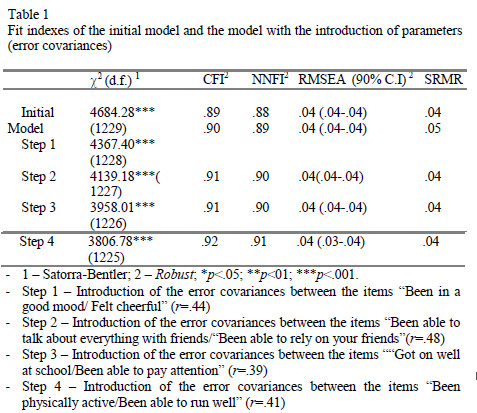
As it is possible to see, the c2 value had a significant drop in each of the steps related to the introduction of error covariances in the model (free estimation). In the last step the c2 value [Satorra-Bentler c2= 3806.78 (1225), p<.001; c2/df=3, 1], although significant, which is often observed with large sample sizes (Cheung & Resenvold, 2002), is lower than in first analysis. Also the CFI and the other fit indexes had shown an improvement in each step (Final step: CFI=.92; NNFI=.91; RMSEA=.04; SRMR=.04).
The Wald tests confirmed that all parameters included in the initial model are significant and, therefore, were maintained. Table 2 presents the factor loadings of the final model. As it is possible to see all factor loadings are higher than .50, with the exception of one item of Self-Perception factor (worried about the way he/she looks) that has a loading lower than .20. Table 3 presents the correlations between the 10 factors.
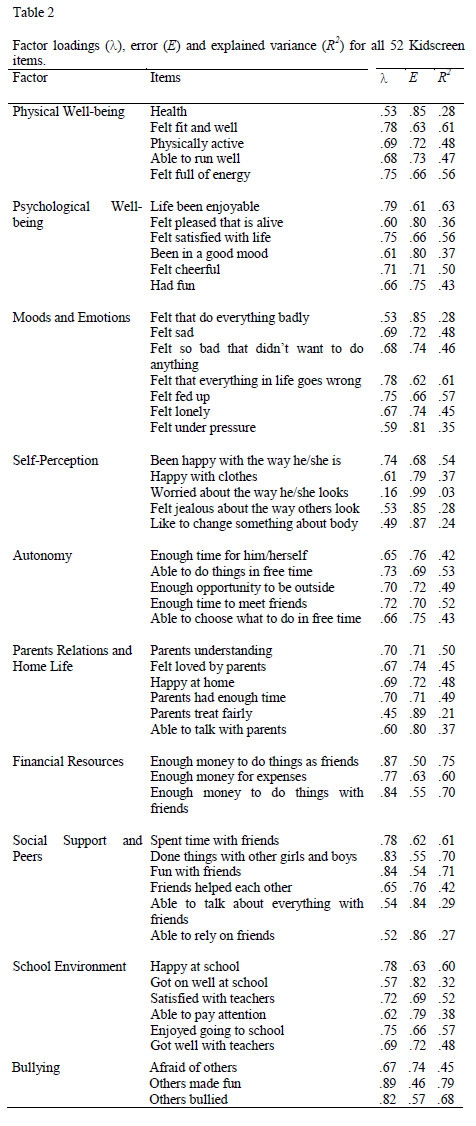
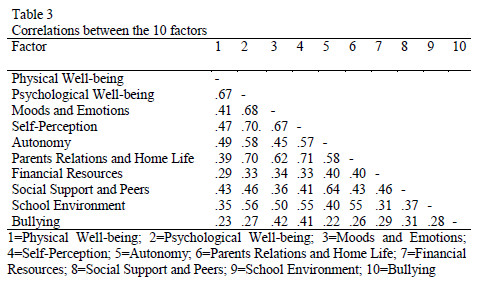
Factorial Invariance
To determine the factorial invariance of the 52-item KIDSCREEN parents version, comparisons across groups were conducted. The variables in study were: (1) gender of the child - male (n = 1041) vs. female (n = 1214); (2) grade (proxy for age) – 5th (n = 1241) vs. 7th (n = 1015).
Results for factorial invariance are summarized in Table 4, where adjustment indexes for both unconstrained and constrained models are shown.
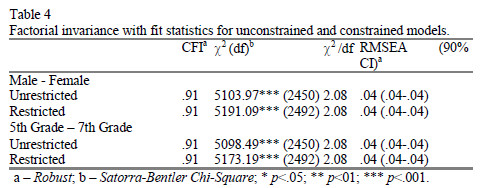
The factorial structure of the questionnaire was confirmed for the unconstrained models since it presents adequate fit indexes (CFI and RMSEA) in each of the paired groups. Metric invariance is also observed as CFI difference between unconstrained and constrained models is smaller than .01 in all paired groups. Table 5 represents factor loadings and explained variances of each item for all groups. The majority of the items have good factor loadings (above .60). Nevertheless, regarding the different factors across the four groups, it is possible to find items that are better explained than others. Financial resources is the factor with better factor loading across the four different groups.
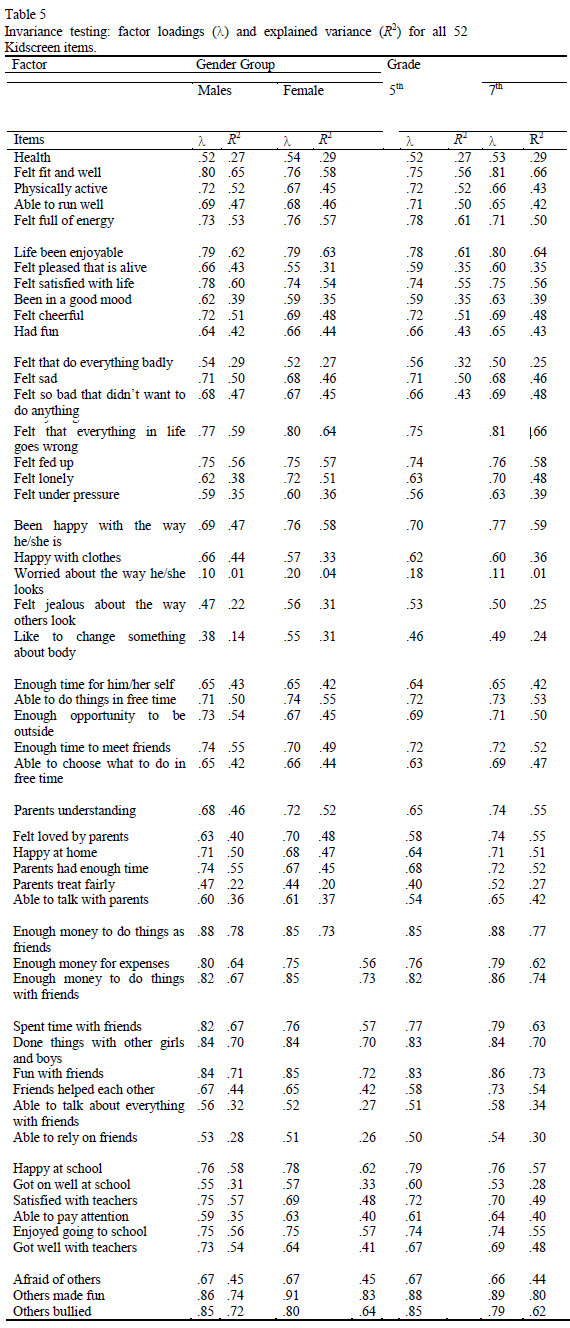
Furthermore, the scales descriptive analysis and the internal consistency of KIDSCREEN-52 dimensions in Portugal – parents version - showed a good internal consistency for all scales, except Self-perceptions (Table 6).
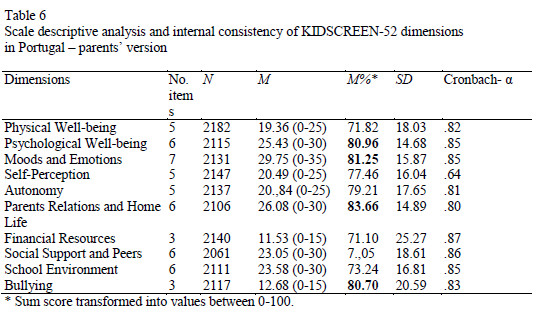
Parents tended to perceive their daughters as having better quality of life regarding the dimensions of School Environment, Bullying and Financial Resources and they tended to perceive their sons as having better quality of life regarding the dimensions Physical Well Being, Self-Perception, and Autonomy. The effect size analysis highlighted that these differences, although significant, are small (Cohen, 1988) (See Table 7).
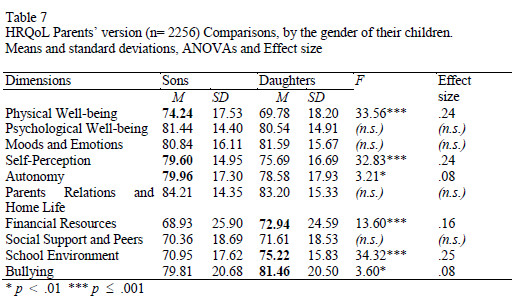
Parents tended to perceive their younger children (5th grade) as having better quality of life than the older children on all the dimensions, except in the dimension Social Support and Peers, where there was no statistically significant difference, and regarding Bullying, where parents perceived a better situation in the older (7th grade) group. The effect size analysis highlighted that although significant, most of the differences are small or average (the School Environment dimension is better perceived in younger children and it is indeed the higher effect size in all the comparisons) (See Table 8).
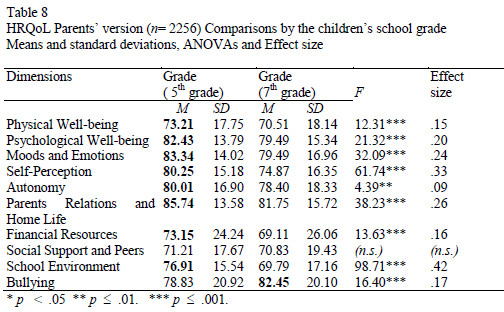
DISCUSSION
The purpose of this paper was to examine psychometric properties of the KIDSCREEN-52, parents version, in order to validate this instrument for Portuguese children and adolescents parents, and analyse parental perceptions related to the childs gender (boy or girl) and their age (school grade).
In the final solution, the RMSEA was lower than .04, the upper limit of 90% confidence interval was also lower than .04, and CFI was higher than .90. All the factor loadings were higher than .50 with the exception of the item worried about the way it looks that had a very low loading. Furthermore, results indicate that the current 52-item structure is invariant across gender groups, and grade. The CFI for both models was good (above .90) and changes were bellow .01 (Cheung & Rensvold, 2002). Again, the factor loading of the item worried about the way it looks (Self-Perception factor) had a very low loading in all the groups under analysis. This item was maintained in the structure of Kidscreen-52 nevertheless, based on the results, its removal from the scale should be considered. The internal consistency analysis points in the same direction.
Parents seem to have different perceptions of their childrens HRQoL according to the gender of their children (sons/daughters). Those differences are, in general, in line with the differences that their children also reported, reflecting cultural gendered differences ( e.g. more positive views of girls perception of schooling and boys more optimistic view of life) (Gaspar & Matos, 2008; Matos & Sampaio, 2009; Matos et al, 2012)
In general, parents estimated their daughters to have a better experience of schooling and less involvement in bullying, and their sons as having a better physical health, a better self-perception and higher autonomy. These findings agree with the general literature on gender differences and also with the general gender differences in beliefs, which suggest that both children and their families are prone to perceive gender differences. They also corroborated previous research either in the area of health-related quality of life or in the area of developmental psychology (Caldera & Hart, 2004; Matos et al, 2012).
Finally, parents seem to have different perceptions according to their childs age (school grade), that correspond with their own childs perception, namely highlighting a decrease of HRQoL in almost all HRQoL dimensions, except Bullying. The higher difference effect is the notorious decrease of HRQoL with age, in which School matters are concerned (Gaspar & Matos, 2008; Matos & Sampaio, 2009; Matos et al, 2012, 2012)
The results showed that KIDSCREEN-52 questionnaire (parents version) is a valid, reliable and sensitive instrument to estimate the parents perception of quality of life both for their children and for adolescents in the Portuguese language and in their culture (Gaspar, et al, 2010; Gaspar & Matos, 2008), in the same way as it happened in other countries (Ravens-Sieberer et al., 2001; 2005; The KIDSCREEN Group Europe, 2006).
Data collection through a reliable instrument to assess health-related quality of life allows monitoring of the health of children, one of the key issues in both public health and health psychology (Ribeiro, 1994).
REFERÊNCIAS
Boosman, K., Meulen, M., Geert, P., & Jackson, S. (2002). Measuring young childrens perceptions of support, control and maintenance in their social networks. Social Development, 11, 386-408. doi: 10.1111/1467-9507.00206 [ Links ]
Caldera, Y., & Hart, S. (2004). Exposure to Child care, parenting Style and attachment Security. Infant and Child Development, 13, 21-33. doi: 10.1002/icd.329 [ Links ]
Chang, P., & Yeh, C. (2005). Agreement between Child Self-Report and Parent Proxy-Report to Evaluate Quality of Life in Children with Cancer. Psycho-Oncology, 14, 125-134. doi: 10.1002/pon.828 [ Links ]
Cheung, G. W., & Rensvold, R. B. (2000). Testing measurement invariance using critical values of fit indices: A Monte Carlo study Retrieved 20-02-2004, retrieved from http://www.aom.pace.edu/rmd/cheung_files/cheung.htm [ Links ]
Cheung, G. W., & Rensvold, R. B. (2002). Evaluating goodness-of-fit indexes for testing measurement invariance. Structural Equation Modeling, 9, 233-255. doi:10.1207/S15328007SEM0902_5 [ Links ]
Cohen, J. (1988). Statistical Power Analysis for the Behavioural Sciences (2nd ed.). Hillsdale, NJ: LEA [ Links ]
Coventry, W., Gillespie, N., Heath, A., & Martin, N. (2004). Perceived social support in a large community sample: age and sex differences. Social Psychiatry and Psychiatric Epidemiology, 39, 625-636. doi:10.1007/s00127-004-0795-8 [ Links ]
Currie, C., Samdal, O., Boyce, W., & Smith, R. (2001). HBSC, a WHO cross national study: research protocol for the 2001/2002 survey. Copenhagen: WHO. [ Links ]
Ethgen, O., Vanparijs, P., Delhalle, S., Rosant, S., Bruyére, O., & Reginster, I. (2004). Social support and health-related quality of life in hip and knee osteoarthritis. Quality of Life Research, 13, 321-330. doi:10.1023/B:QURE.0000018492.40262.d1 [ Links ]
Eiser, C., & Morse, R. (2001). Can parents rate their childs health-related quality of life? Results of a systematic review. Quality of Life Research, 10, 347-357. doi: 10.1023/A:1012253723272 [ Links ]
Gaspar, T. (2010). Health-Related Quality of Life in Children and Adolescents: Personal and Social Factors that promote quality of life. German: Lambert Academic Publishing. [ Links ]
Gaspar, T., Matos, M. G., Pais Ribeiro, J., Leal, I., & Ferreira, A. (2009). Health-related quality of life in children and adolescents and associated factors. Journal of Cognitive and Behavioral Psychotherapies, 9, 33-48. [ Links ]
Gaspar, T., Matos, M. G., Pais Ribeiro, J. L., Leal, I., Erhart, M., & Ravens-Sieberer, U.(2010a). Kidscreen: Quality of Life in Children and Adolescents. Journal of Child and Adolescent Psychology, 1, 49-64. [ Links ]
Gaspar, T., Matos, M. G., Batista-Foguet, J. Pais Ribeiro, J., Leal, I., Erhart, M., & Ravens-Sieberer, U.(2010b). Parent-child perceptions of quality of life: Implications for health intervention, Journal of Family Studies, 16 , 143-154. doi: 10.5172/jfs.16.2.143 [ Links ]
Gaspar, T., & Matos, M. G. (Eds) (2008). Versão portuguesa dos instrumentos KIDSCREEN-52: Instrumentos de Qualidade de Vida para Crianças e Adolescentes. FMH: Lisboa [ Links ]
Helgeson, V. (2003). Social support and quality of life. Quality of Life Research, 12 , 25-31. [ Links ]
Jokovic, A., Locker, D., & Guyatt, G. (2004). How well do parents know their children? Implication for proxy reporting of child health-related quality of life. Quality of Life Research, 13, 1297-1307. doi: 10.1023/B:QURE.0000037480.65972.eb [ Links ]
Hu, L., & Bentler, P. (1999). Cuttoff criteria for fit indices in covariance structure analysis: conventional criteria versus new alternatives. Structural Equation Modeling, 6, 1-55. [ Links ]
KannaIaupuni, S., Donato, K., Thompson-Colón, T., & Stainback, M. (2005). Counting on Kin: social network, social support and children health status. Social Forces, 83 1137-1164. doi:10.1353/sof.2005.0036 [ Links ]
Kline, R. B. (2005). Principles and practice of structural equation modelling. Second edition. New York: Guilford Press. [ Links ]
Matos, M. G. (2005). Gestão de Conflitos e Saúde na Escola. (Conflit management and health in school). Lisbon, CDI: FMH. [ Links ]
Matos, M. G., & Equipa do Projecto Aventura Social & Saúde (2003). A Saúde dos Adolescentes Portugueses (Quatro anos depois).(The health of Portuguese adolescents- four years after). Lisbon: FMH/UTL & CMDT/UNL. [ Links ]
Matos, M. G., & Equipa do Aventura Social (2012). A Saúde dos Adolescentes Portugueses – (The health of Portuguese adolescents) HBSC 2010. Lisbon: CMDT/UNL & UTL.
Matos, M. G., & Sampaio, D. (2009). Jovens com saúde (Healthy young people). Lisbon: Leya. [ Links ]
Nelson, G., Laurendeau, M., & Chamberland, C. (2001). A Review of Programs to Promote Family Wellness and Prevent the Maltreatment of Children. Canadian Journal of Behavioural Science, 33 (1) 1-13. doi:10.1037/h0087123 [ Links ]
Ravens-Sieberer, U., Gosch, A., Abel, T., Auquier, P., Bellach, B., Bruil, J., European KIDSCREEN Group. (2001). Quality of life in children and adolescents: a European public health perspective. Sozial und Praventivmedizin, 46, 294-302. doi:10.1007/BF01321080 [ Links ]
Ravens-Sieberer, U., Gosch, A., Rajmil, L., Erhart, M., Bruil, J., Duer, KIDSCREEN group. (2005). KIDSCREEN-52 quality-of-life measure for children and adolescents. Expert Review Pharmacoeconomics & Outcomes Research 5(3), 53-61. doi: 10.1586/14737167.5.3.353. [ Links ]
The KIDSCREEN Group Europe. (2006). The KIDSCREEN questionnaires: quality of life questionnaires for children and adolescents. Germany, Pabst Science Publishers. [ Links ]
Theunissen, N., Vogels, T., Koopman, H., Verrips, G., Zwinderman, K. Verloove-Vanhorick, S., & Wit, J. (1998). The Proxy problem: Child report versus parent report in health-related quality of life research. Quality of Life Research, 7, 387-397. doi: 10.1023/A:1008801802877 [ Links ]
Varni, J., Limbers, C., & Burwinkle, T. (2007). Parent proxy-report of their childrens health-related quality of life: an analysis of 13,878 parents reliability and validity across age subgroups using PedsQL 4.0 Generic Core Scales. Health and Quality of Life Outcomes, 5 (2). http://hqlo.com/content/5/1/2. [ Links ]
Recebido em 29 de Agosto de 2013/ Aceite em 14 de Outubro de 2013
Acknowledgements
The authors would like to thank the Social Adventure team for the collaboration in data collection and analysis (www.aventurasocial.com) and Professor Doctor Ulrike Ravens-Sieberer (KIDSCREEN European Group Coordinator) for methodological assistance and, finally, all The KIDSCREEN Group Europe (www.KIDSCREEN.org).













